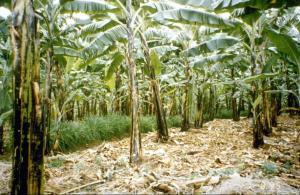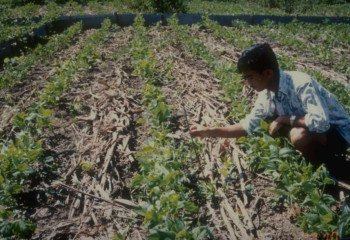Mulching is use of plant material such as straw, leaves, crop residues, green manure crops, or saw-dust, stones or plastic planes etc. that is spread upon the surface of the soil. A mulch cover helps protect the soil from erosion and evaporation, nourishes soil life, increases soil organic matter content and provides nutrients to the crop.
Geographical Distribution in Africa
Introduction
Mulch is dry, vegetative material used to cover the soil. It helps reduce evaporation and retain moisture, reduce soil erosion, suppress weed growth and provide plant nutrients as the material decomposes.
Mulch can be used in fields before and after planting, as well as around young crop plants. It is especially useful for high-valuable vegetable crops, and for growing crops in dry areas, during dry-season cropping, and in places where the soil is easily eroded by heavy rains. Where soil erosion is a problem, slowly decomposing mulch material (low nitrogen content, high C/N-ratio) will provide a long-term protection compared to quickly decomposing material.
 |
|
Traditional banana mulching in Uganda Note: Mulch should be applied at least 60-90 cm away from the banana stem in order to encourage banana to have more vertical roots: when mulch is applied close to banana stem, it encourages development of more superficial lateral roots, which do not held the plant firmly against wind and exposes the plants to water shortage during short dry spell. |
|
© Will Critchley, Amsterdam, The Netherlands (Reproduced from WOCAT, www.wocat.net)
|

Advantages and disadvantages of mulching
What are the advantages of mulching?
- Mulch keeps the soil underneath moist longer than bare soil.
- Controls soil erosion by cushioning the impact of raindrops and by slowing runoff.
- Suppresses weeds by shading them out.
- Leads to healthy crop growth.
What are the disadvantages:
- Mulching is labour-intensive.
- It can introduce new pests and diseases into a field.
- Mulch material may not be available.
How to do it:
1. Carry to the field the material you want to spread as mulch.
2. Spread it on the soil using your hands or a rake. Put a layer of mulch 7-15 cm (3-6 inches) deep all over the bed, or around the growing plants. Do not put on so much mulch that you bury the plants or shade them out.
Do's and Dont's:
- Use dry plant material that does not rot quickly.
- Don't use wet or green material as mulch.
Constraints of mulching
Some organisms can proliferate too much in the moist and protected conditions of the mulch layer. Slugs and snails can multiply very quickly under a mulch layer. Ants or termites which may cause damage to the crops also may find ideal conditions for living. When crop residues are used for mulching, in some cases there is an increased risk of sustaining pests and diseases.
Damaging organisms such as stem borers may survive in the stalks of crops like cotton, corn or sugar cane. Plant material infected with viral or fungal diseases should not be used if there is a risk that the disease might spread to the next crop. Crop rotation is very important to overcome these problems.
When carbon rich materials such as straw or stalks are used for mulching, nitrogen from the soil may be used by microorganisms for decomposing the material. Thus, nitrogen may be temporary not available for plant growth (risk of N-immobilisation).
Risk of Nitrogen-immobilisation:
When organic material is applied to the soil, the decomposing microbes multiply quickly. For growth, they need nutrients, especially nitrogen, like plants do. If the applied plant material does not contain sufficient nitrogen, the micro-organisms will take it from the soil. This process is called nitrogen immobilisation, as the nitrogen is fixed temporarily in the microbes and released only after some time. During this time, the microbes compete with the plants for nitrogen and the crop may suffer from malnutrition.
How to prevent N-immobilisation?
- Old or rough plant materials should be applied to the soil at least 2 months before planting or sowing the main crop
- Nitrogen immobilisation can occur when the following materials are applied: straw or grain husks, material containing wood (e.g. twigs, saw dust), half rotten compost
Information Source Links
- Sustainable Agriculture Extension Manual for Eastern and Southern Africa. Available online at www.iirr.org. Accessed on 9.8.2007
- Eyhorn, F., Heeb, M., Weidmann, G. (2002). IFOAM Training Manual for Organic Agriculture in the Tropics, Compiled by FiBL.
